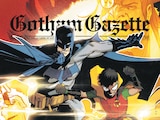The best Batman stories are the ones that center his humanity. After all, Batman is an ordinary person, just as vulnerable as you or me underneath all that armor. But beyond his physical vulnerability, part of what connects Batman to fans is his imperfection. He may be the World’s Greatest Detective, but he certainly isn’t the world’s greatest parent. And while live-action adaptations of Batman have largely stayed away from representing the Bat-Family in its totality, Batman comics offer an intimate look at the Dark Knight’s shortcomings as a parent.
Red Hood and Batman have arguably the tensest relationship in the Bat-Family, established in the masterful “Under the Hood” arc in Batman #635-641, #645-650 and Batman Annual #25 by Judd Winick, Doug Mahnke, Shane Davis, Eric Battle and Paul Lee. “Under the Hood” is also known as “Under the Red Hood,” with the storyline faithfully adapted into the 2010 animated film, Batman: Under the Red Hood. It tells the story of a new villain named Red Hood who takes control of Gotham’s criminal underground. As Batman and Red Hood fight, he notices his foe’s uncanny ability to predict his next move. To his horror, Batman eventually discovers that Red Hood is actually Jason Todd, his second Robin who was killed by the Joker during the events of 1988’s “A Death in the Family” arc in Batman.

“Under the Hood” was a landmark moment in DC history because it showed Batman dealing with failure, just like any other parent. Jason Todd’s return put into question whether Batman could ever truly break the cycle of grief, even after his success with his third Robin, Tim Drake. In this sense, the resurgence of Red Hood as a villain signified a new type of enemy that Batman had to confront: his own past. In facing Jason, Bruce had the choice of punishing his shortcomings or learning how to live with them. Thankfully for all of us Jason Todd fans, Batman and Red Hood were able to eventually smooth out their relationship.
Like any stellar Batman story, “Under the Hood” challenges one specific part of Batman’s identity. Batman stories that take this approach typically center on his relationship to his city (Scott Snyder and Greg Capullo’s “Court of Owls Saga” being a great example, alongside Frank Miller, Klaus Janson, and Lynn Varley’s Batman: The Dark Knight Returns) or his relationship to his vigilante persona (Grant Morrison and Dave McKean’s Batman: Arkham Asylum, Chip Zdarsky and Jorge Jiménez’s recent “Failsafe” arc in Batman).
But “Under the Hood” places Batman’s life as a father at the forefront, transforming the Caped Crusader from an orphan to a parent who lost a child—a state we don’t even have a word for in the English language. In this sense, Winick’s writing cemented an additional pillar to the Batman mythos, one that cannot be ignored by both creators and fans now. His struggles as a parent are just as compelling as his struggles as a vigilante and Gothamite. Just look at Snyder and Capullo’s Batman: Death of the Family, and the heartbreaking “Cheer” storyline by Chip Zdarsky, Eddy Barrows and Eber Ferreira in Batman: Urban Legends.

What makes this specific element so enticing is that Batman can’t approach his parenting problems with the same dogged, almost paranoid intensity as his crimefighting. That is, as arguably the most prepared person in the DC Universe for any type of situation or foe, Batman can’t easily devise a tool to help him be a better father. Winick’s writing illustrates this in Batman #645 during a flashback when Alfred recalls the first time Bruce realized that “Jason had a ‘mean streak’” that Dick Grayson didn’t have: “And as a father… [Bruce] was at a loss for what to do.”
As we move back to the present, Batman admits that he’s been “blind, arrogant, careless and stupid.” Not about his actions as a parent, but about the coffin in front of him that he once believed held the remains of his former sidekick. He goes on to explain how he’s “gone over every inch of it, trying to find any clue of tampering…and while searching for those markers…those mistakes…I overlooked something…”
Here, Batman isn’t talking about the coffin so much as he’s demonstrating his own cognitive dissonance. Jason’s return, and the subsequent flood of memories and reflections, can’t be dealt with through a typical investigation by Batman. The evidence of his new emotional reality—the “clue of tampering”—isn’t even observable. What’s even more heartbreaking is that Bruce isn’t fully aware of how he’s overlooked “those mistakes” of his past with Jason, instead compartmentalizing it all into his examination of Jason’s coffin. Bruce’s work as Batman is ultimately a distraction from the more troubling, confounding dimensions of parenthood.

Today, Batman is stronger because of the Bat-Family, but that strength didn’t materialize overnight. In “Under the Hood,” Batman was forced to exorcise his buried children, paving the way for Red Hood to become the nuanced voice of criticism within the Bat-Family.
While most deaths in comics aren’t permanent, Jason Todd’s return in 2005 was an earth-shattering moment. By exploring the effects that Jason’s return had on Batman, writer Judd Winick infused “Under the Hood” with an appropriate sense of humanity. And as Batman discovers, to be human is to be messy, making “Under the Hood” a cathartic, evergreen story.
Batman: Under the Red Hood (originally known as “Under the Hood”) by Judd Winick, Doug Mahnke, Shane Davis, Eric Battle and Paul Lee is available in print as a graphic novel and on DC UNIVERSE INFINITE.
Jules Chin Greene writes about comics for DC.com, and his work can also be found at Nerdist, Popverse and Multiverse of Color. You can follow him on Twitter and Bluesky at @JulesChinGreene.
NOTE: The views and opinions expressed in this feature are solely those of Jules Chin Greene and do not necessarily reflect those of DC or Warner Bros. Discovery, nor should they be read as confirmation or denial of future DC plans.















